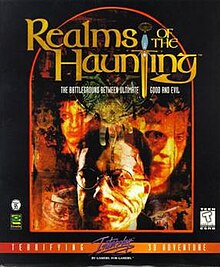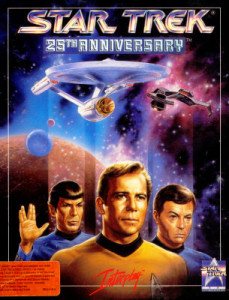
Star Trek: 25th Anniversary is an adventure video game developed and published by Interplay Productions in 1992, based on the Star Trek universe. The game chronicles various missions of James T. Kirk and his crew of the USS Enterprise. Its 1993 sequel, Star Trek: Judgment Rites, continues and concludes this two-game series.

The 7th Guest is an interactive movie puzzle adventure game, produced by Trilobyte and originally released by Virgin Interactive Entertainment in April 1993. It is one of the first computer video games to be released only on CD-ROM. The 7th Guest is a horror story told from the unfolding perspective of the player, as an amnesiac. The game received a great amount of press attention for making live action video clips a core part of its gameplay, for its unprecedented amount of pre-rendered 3D graphics, and for its adult content. In addition, the game was very successful, with over two million copies sold. It, alongside Myst, is widely regarded as a killer app that accelerated the sales of CD-ROM drives. The 7th Guest has subsequently been re-released on Apple's app store for various systems such as the Mac. Bill Gates called The 7th Guest "the new standard in interactive entertainment".

Alone in the Dark 2 is a 1993 survival horror video game developed and published by Infogrames. It is the second installment in the Alone in the Dark series. It was ported to the PC-98 and FM Towns in 1994 and to the 3DO Interactive Multiplayer in 1995 under the same name, and to the Sega Saturn and PlayStation in 1996 as Alone in the Dark: Jack is Back in Europe, and renamed as Alone in the Dark: One-Eyed Jack's Revenge in North America.

Crusader: No Remorse is an action game developed by Origin Systems and published by Electronic Arts. It was first released in 1995 for MS-DOS, with the Sony PlayStation and Sega Saturn ports following in 1997. Set in a dystopian future 22nd century, the game centers on The Captain, a special ops officer and supersoldier, who defects from the tyrannical world government, the World Economic Consortium (WEC), and joins the Resistance rebels.

Toonstruck is a graphic adventure video game developed by Burst Studios, published by Virgin Interactive Entertainment and released in 1996 for DOS. In the game, a live-action protagonist Drew Blanc, played and voiced by Christopher Lloyd, is transported into the cartoon world he created while suffering from a creative block. Blanc is accompanied by his animated sidekick Flux Wildly, voiced by Dan Castellaneta.
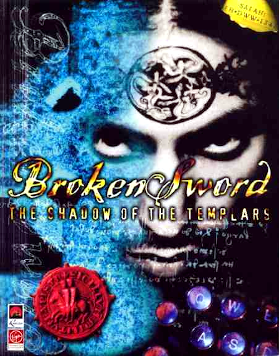
Broken Sword: The Shadow of the Templars is a 1996 point-and-click adventure game, and the first in the Broken Sword series, co-written and directed by Charles Cecil, and developed by Revolution Software. The player assumes the role of George Stobbart, an American tourist in Paris, as he attempts to unravel a deep conspiracy involving a sinister cult and a hidden treasure, seeing him travel to various locations around Europe and the Middle East. The game's storyline was conceived to feature a serious tone and heavily influenced by research on Knights Templar by Cecil, but was also interlaced with humor and graphics in the style of classic animated films.

Dragon Lore: The Legend Begins is a point-and-click adventure game released in 1994 by Cryo Interactive for MS-DOS, and later ported to the 3DO video game console. The game was a commercial success, with sales of 300,000 units by 1997. An emulated version was released for Microsoft Windows and macOS in 2013.

Normality is a 3D graphic adventure, released in June 1996 by Gremlin Interactive. All cut-scenes in the game are pre-rendered. The game's engine was later used in the game Realms of the Haunting. It was re-released in 2011 with Microsoft Windows support on GOG.com, with macOS support following in 2013 and Linux support in 2014.

Broken Sword II: The Smoking Mirror is a point-and-click adventure video game originally released on Microsoft Windows and PlayStation in 1997. It was re-released on Microsoft Windows, OS X and iOS as a remastered edition in 2010 and on Android in 2012. It is the second installment in the Broken Sword series, and the first game in the series that does not follow the Knights Templar storyline. The player assumes the role of George Stobbart, a young American who is an eyewitness to the kidnapping of his girlfriend Nicole Collard.
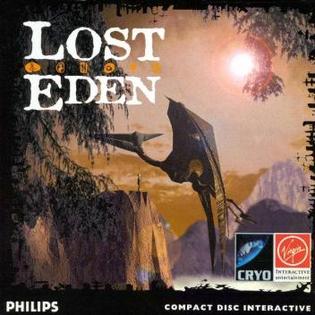
Lost Eden is an adventure game developed by Cryo and published by Virgin Interactive in March 1995 for MS-DOS, Macintosh, 3DO, and CD-i. It is set in a world where humans and dinosaurs coexist.
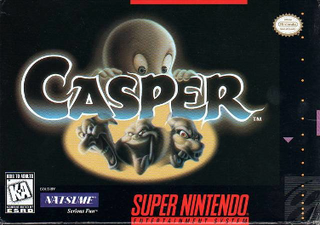
Casper is a series of action-adventure games based on the 1995 film of the same name. Two different games were released in 1996 and 1997 for the Super Nintendo Entertainment System, by different publishers, in different regions. A third game was released for the 3DO, Sega Saturn, PlayStation, and Game Boy Color, published by Interplay Productions. There was also a Game Boy game developed by Bonsai. A PC game, Casper: The Interactive Adventure, and a Game Boy Advance game, simply titled Casper, were released in 1997 and 2002 respectively serving as sequels.

Lands of Lore: Guardians of Destiny is a 1997 action role-playing game, second installment of the Lands of Lore series, a sequel to Lands of Lore: The Throne of Chaos. It brought about a drastic change in gameplay style from its predecessor, opting away from the original's D&D turn-based style in favor of more action elements. A sequel, Lands of Lore III, was released in 1999.

The Legend of Kyrandia: Book Three - Malcolm's Revenge is a 2D point-and-click adventure game, developed by Westwood Studios and published by Virgin Interactive in 1994. It is the sequel to The Legend of Kyrandia: Hand of Fate, and the third and final game in the Fables & Fiends series. The game sees players take on the role of the antagonist from the first game in the series, who begins plotting his revenge against those who thwarted him, only to find himself eventually seeking to prove his innocence of a murder he did not commit.
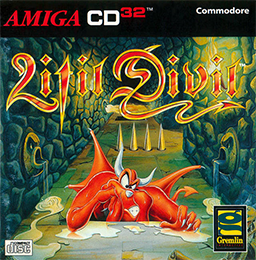
Litil Divil is a video game released by Gremlin Graphics Software in 1993. The game stars Mutt, a dog-like devil in the Underworld whose goal is to obtain the "Mystical Pizza of Plenty" from the Labyrinth of Chaos. Litil Divil's release was delayed several times, and the game was initially advertised in magazines under the name Little Divil.

Actua Golf is a sports video game developed and published by Gremlin Interactive for PlayStation and Sega Saturn.
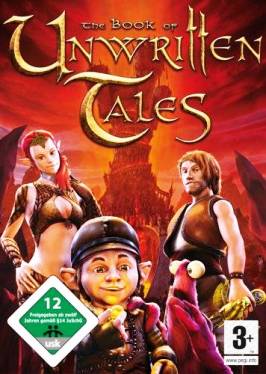
The Book of Unwritten Tales is a point-and-click adventure video game created by German developer King Art Games. A prequel called The Book of Unwritten Tales: The Critter Chronicles was released in 2012. A sequel, The Book of Unwritten Tales 2, was released on February 20, 2015.

King's Quest: Mask of Eternity is a hybrid point-and-click adventure and action-adventure video game developed and published by Sierra Studios in 1998. It was the eighth official game in the King's Quest series, the first and only game in the main series where the main character is neither King Graham nor a member of his family, as well as the first in the series to use a full 3D engine as opposed to the 2D cartoon or pixel style of the earlier games and the first to omit the sequel numbering system on box artwork and title screen.
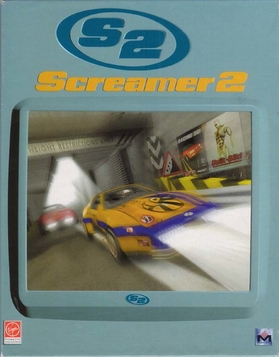
Screamer 2 is a video game developed by Milestone and published by Virgin Interactive Entertainment, released in 1996 on September 30 in North America and November 15 in Europe. It is the second game in the Screamer series. Unlike its predecessor, which drew heavily from Namco's Ridge Racer, Screamer 2 moved towards a rally-oriented style, replacing the six high-performance road cars of the previous game with four rally cars. The game supports up to two players using a split screen and up to four players over a network. A sequel, Screamer Rally, was released in 1997.

Pro Pinball: Fantastic Journey is an action video game developed by Cunning Developments, published by Empire Interactive and distributed by Take-Two Interactive for Microsoft Windows and PlayStation. It is the fourth game in the Pro Pinball series. Elements of the game include combinations of Victorian era settings, steam powered machinery, steampunk style nautical adventures, and fictional islands.
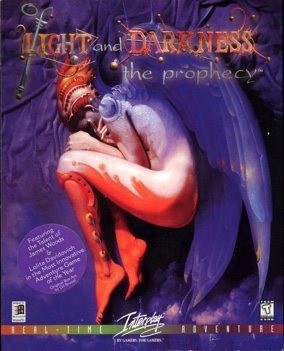
Of Light and Darkness: The Prophecy, also known as simply Of Light and Darkness, is a first-person point-and-click adventure video game developed by Tribal Dreams and published by Interplay Entertainment in 1998.
